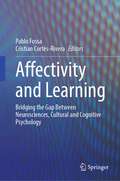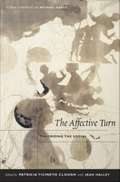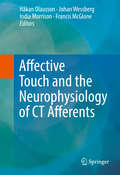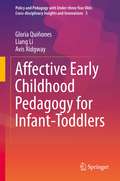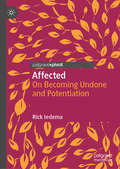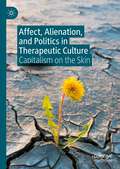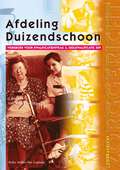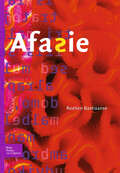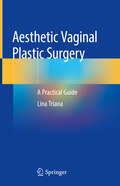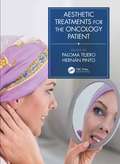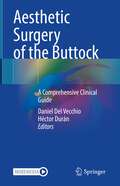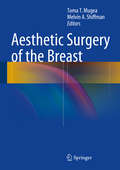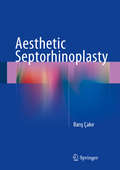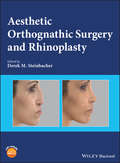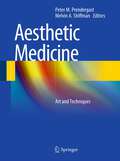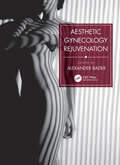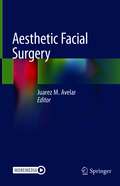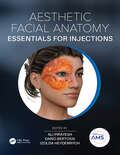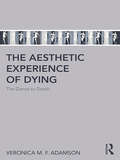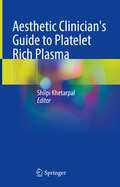- Table View
- List View
Affectivity and Learning: Bridging the Gap Between Neurosciences, Cultural and Cognitive Psychology
by Pablo Fossa Cristian Cortés-RiveraThis book presents an interdisciplinary approach to the study of affectivity and human learning by bridging the gap between neuroscience, cultural and cognitive psychology. It brings together studies that go beyond the focus on cognitive-intellectual variables involved in learning processes and incorporate the study of the role played by affectivity and emotions in learning not only at educational settings but in all processes of transformation and human development, thus presenting affectivity as a catalyst and mediator of all daily learning processes.Chapters brought together in this contributed volume present both theoretical contributions and results of empirical research from different disciplines, such as neuroscience, cognitive psychology, cultural psychology, educational psychology, developmental psychology and philosophy, and are grouped into five thematic sections. The first part of the book brings together chapters discussing different aspects of the role played by affectivity in learning processes from the perspectives of cultural, educational and developmental psychology. The second part is dedicated to the role of affectivity for teachers during their training as educators and during their pedagogical practice in diverse contexts. The third part focuses on the relationship between affectivity and learning from a neuroscientific point of view. The fourth part discusses affectivity and learning in therapeutic and clinical contexts. Finally, the fifth part brings together chapters about affectivity and learning in everyday life.By bringing together this rich interdisciplinary collection of studies, Affectivity and Learning: Bridging the Gap Between Neurosciences, Cultural and Cognitive Psychology will be a valuable resource for researchers in the fields of psychology, neuroscience and education, as well as for educators and teachers interested in knowing more about the relationship between affectivity and human learning.
The Affective Turn: Theorizing the Social
by Patricia Ticineto Clough Jean Halley"The innovative essays in this volume . . . demonstrat[e] the potential of the perspective of the affects in a wide range of fields and with a variety of methodological approaches. Some of the essays . . . use fieldwork to investigate the functions of affects--among organized sex workers, health care workers, and in the modeling industry. Others employ the discourses of microbiology, thermodynamics, information sciences, and cinema studies to rethink the body and the affects in terms of technology. Still others explore the affects of trauma in the context of immigration and war. And throughout all the essays run serious theoretical reflections on the powers of the affects and the political possibilities they pose for research and practice. "--Michael Hardt, from the foreword In the mid-1990s, scholars turned their attention toward the ways that ongoing political, economic, and cultural transformations were changing the realm of the social, specifically that aspect of it described by the notion of affect: pre-individual bodily forces, linked to autonomic responses, which augment or diminish a body's capacity to act or engage with others. This "affective turn" and the new configurations of bodies, technology, and matter that it reveals, is the subject of this collection of essays. Scholars based in sociology, cultural studies, science studies, and women's studies illuminate the movement in thought from a psychoanalytically informed criticism of subject identity, representation, and trauma to an engagement with information and affect; from a privileging of the organic body to an exploration of nonorganic life; and from the presumption of equilibrium-seeking closed systems to an engagement with the complexity of open systems under far-from-equilibrium conditions. Taken together, these essays suggest that attending to the affective turn is necessary to theorizing the social. Contributors. Jamie "Skye" Bianco, Grace M. Cho, Patricia Ticineto Clough, Melissa Ditmore, Ariel Ducey, Deborah Gambs, Karen Wendy Gilbert, Greg Goldberg, Jean Halley, Hosu Kim, David Staples, Craig Willse , Elizabeth Wissinger , Jonathan R. Wynn
Affective Touch and the Neurophysiology of CT Afferents
by Håkan Olausson Johan Wessberg India Morrison Francis McgloneCT afferents are receptors in mammalian hairy skin that fire action potentials when the skin is touched lightly which makes them particularly important in affective touch. Traditionally neuroscientific research has focused on more discriminative and haptic properties of touch that are mediated by large myelinated afferents and the coding properties and functional organization of unmyelinated CT afferents have been studied much less. The proposed volume will draw together existing knowledge in this nascent field. Separate sections will address (1) how we can measure affective touch, (2) CT structure and physiology, (3) CT processing, (4) the contribution of CTs to sexual behavior, (5) clinical relevance, (6) commercial relevance, and (7) future research considerations.
Affective Early Childhood Pedagogy for Infant-Toddlers (Policy and Pedagogy with Under-three Year Olds: Cross-disciplinary Insights and Innovations #3)
by Gloria Quiñones Liang Li Avis RidgwayThis exciting new book brings fresh knowledge of affective pedagogies in early childhood education and care. The book draws on cultural-historical theory in alignment with visual methodologies to elucidate infant-toddlers’ affective pedagogies through analysis of case examples. The book reveals contemporary pedagogical practices in the infant-toddler space like mealtimes, nappy change and play. These pedagogical practices show the highly specialised nature of working with infant-toddlers such as the affective relations between educators and infant-toddlers, affective dialogue, affective engagement, and the creation of affective spaces. The value of collaboration is highlighted through creating an affective space for educators to become aware, reflect and position themselves as effective and affective educators. The book introduces innovative methodological tools such as images and collective drawings for collaborative reflection.
Affected: On Becoming Undone and Potentiation
by Rick IedemaThis book explores the implications and relevancies of personal affect and organisational complexity for navigating organisational processes, relationships, changes and aspirations. In today’s climate, worker roles, relations and responsibilities are becoming increasingly complex and variable. Using personal experiences of organisational conflict as a point of departure, this book reflects on organisational change, complexity and research.It moves from experiential towards theoretical and methodological issues, exploring the question of how to confront and intervene in organisational complexity. Among others, the main theories brought to bear on this question include complexity theory, affect theory and sphere theory (or ‘spherology’). The research approaches and methodologies discussed include anthropology/ethnography, discourse studies, visual research and (the turn to) participatory enquiry.The book’s main message is to advocate for a collaborative, affective, visualised and future-oriented research agenda that rejects the conventional objectivist break and ‘division of learning’ characterising researcher-researched relationships. It will appeal to students and academics working in the fields of alternative research methods, the social sciences, organisational studies and management theory.
Affect, Alienation, and Politics in Therapeutic Culture: Capitalism on the Skin
by Suvi SalmenniemiThis book contributes to research on therapeutic culture by drawing on longstanding ethnographic work and by offering a new theoretical reading of therapeutic culture in today's society. It suggests that the therapeutic field serves as a key site in which a number of contradictions of capitalism are confronted and lived out. It shows that therapeutic engagements are inherently ambivalent and contradictory, as they can be articulated and engaged with in many different ways and harnessed for diverse, and often contradictory, political projects. The book takes issue with the interpretation of therapeutic culture as merely individualising, depoliticizing and working in congruence with neoliberalism, and shows that therapeutic engagements may also open up a space for contestation and critique of neoliberal capitalism, animate collective action for social change and articulate alternative forms of life and subjectivities. The book will speak to a wide variety of audiences in the social sciences and will be of particular interest to those working in the fields of sociology, anthropology, critical psychology, cultural studies, gender studies, and critical social theory.
Afdeling Duizendschoon: Werkboek voor kwalificatieniveau 3, deelkwalificatie 309 (Zorggericht)
by J. Korhorn W. Vries-PrinsZorgcategorie: Geriatrische zorgvrager Setting: WoonzorgcentrumKorte inhoud: De afdeling Duizendschoon is een afdeling in een verpleeghuis. De bewoners hebben psychogeriatrische problemen. Ze kunnen niet meer thuis wonen. Bij een blijvende opname wordt de woning verkocht of de huur opgezegd en alle eigendommen en meubels worden door de familie weggedaan. De verpleegafdeling is echt de laatste woonplaats. De mensen die op een psychogeriatrische afdeling in dit verpleeg- huis wonen delen hun kamer met drie andere mensen. Het enige dat zij nog voor zichzelf hebben is een bed, een kledingkast en een nachtkastje. En daarvan kunnen zij niet onthouden dat het van hen is, als ze dement zijn.
Afasie
by Roelien BastiaanseAfasie is een taalstoornis ten gevolge van hersenletsel, bijvoorbeeld na een beroerte. Iemand die lijdt aan afasie kan niet meer normaal over zijn taalvermogen beschikken en zal daardoor communicatieproblemen ondervinden die niet alleen grote gevolgen hebben voor de patiënt zelf, maar ook voor zijn omgeving. Verschillende disciplines hebben te maken met afasie. Logopedisten en klinisch linguïsten zijn verantwoordelijk voor de diagnostiek en de therapie. Neurologen en revalidatie-artsen zullen niet zelden patiënten zien die aan afasie lijden. Afasie biedt echter ook een blik op de taalverwerkingsprocessen in de hersenen en wordt als zodanig bestudeerd door neurolinguïsten en neuropsychologen. Zij analyseren wat de patiënten wel en niet kunnen en proberen daar patronen in te ontdekken. Zo willen zij inzicht krijgen in de representatie van taal in de hersenen. In dit boek worden de oorzaken van afasie, de symptomen en de afasiesyndromen beschreven. Ook wordt er een historisch beeld geschetst van de ontwikkeling van het vakgebied en komen wetenschappelijke ontwikkelingen aan bod. Een samenhangend overzicht wordt gegeven van het klinische en wetenschappelijke onderzoek naar afasie.
Aetna and the Transformation of Health Care
by Rebecca Henderson Russell A. Eisenstat Matthew PrebleMark Bertolini, chairman and CEO of the health insurer Aetna, faces a number of questions as he seeks to transform Aetna from a classic insurance company into a business that will engage much more deeply with its members around their personal health goals. His strategy depends on Aetna’s ability to facilitate behavioral changes amongst its members to live healthier lives and requires very significant investments in digital capabilities and on-the-ground community-orientated health care resources. Will it work? Can he implement it? The case explores both the strategic issues inherent in this potential transformation and the organizational and leadership questions that it raises. Bertolini is a highly purpose-driven leader, and the case allows for a rich discussion of the degree to which this changes both his strategic and his organizational options.
Aesthetic Vaginal Plastic Surgery: A Practical Guide
by Lina TrianaThis book schematically discusses the available techniques for aesthetic vaginoplasty, including vagina rejuvenation and other related surgical and non-surgical approaches. By furthering our understanding of the field, it promotes a better surgical practice on aesthetic vaginal surgeries. More specifically, this book will enable surgeons to correctly assess patients, choose and plan procedures, and reproduce the most common surgical aesthetic vaginal procedures.Each chapter is written in a pedagogical way, promoting a direct applicability. For each surgical procedure discussed, it features topics such as consultation and patient’s intentions, clinical examination, anatomy and important landmarks, surgical technique and possible complications. Aesthetic Vaginal Plastic Surgery: A Practical Guide is intended for any medical professional interested in vagina aesthetic and rejuvenation procedures, especially those in the fields of plastic surgery, gynecology and urology.
Aesthetic Treatments for the Oncology Patient
by Paloma Tejero and Hernán PintoPhysicians are increasingly recognizing that helping a cancer patient feel good about themselves and about their appearance can be of vital importance in giving them the emotional support and psychological resilience to survive and recover from the side-effects of disease and its treatment. Dermatologists and other aesthetic physicians are in a prime position to help a cancer patient recover lost volume, hydration, and pigmentation in skin, nails, and hair, as well as to advise on nutrition, prostheses, and complentary therapies. This pioneering volume will be an important resource bringing together the expertise in this area, with the practical detail a physician will need.
Aesthetic Surgery of the Buttock: A Comprehensive Clinical Guide
by Daniel Del Vecchio Héctor DuránIn the past five years, buttock surgery has been changing and expanding worldwide, while also attracting media attention. Surgeons have been confronted with a shocking number of requests for buttock augmentation surgeries. Further, as patients become more complex, more complex procedures are called for, such as fat infiltration surgery combined with implants or, for example, modifying the waist-to-hip ratio.Aesthetic Surgery of the Buttock is the first book of its kind, covering all relevant aesthetic issues. It offers essential guidance on performing surgery, but also on avoiding complications due to fat infiltration in large blood vessels and thus avoiding embolisms at the pulmonary level. In addition, much of the book addresses various aspects of fat infiltration, e.g. obtaining, processing and applying this fat. It also discusses implants, which are an excellent option for many patients, as well as new trends in the combination of fat infiltration and implants to achieve more natural results. Given its scope, it represents an invaluable asset for all plastic surgeons around the globe who perform body-contouring surgeries.
Aesthetic Surgery of the Breast
by Melvin A. Shiffman Toma T. MugeaThis book covers all aspects of aesthetic breast surgery in an instructive, step-by-step format. The descriptions of procedures are completely up to date, encompassing newly introduced techniques and recent modifications of established techniques. Individual parts of the book are devoted to breast augmentation, mastopexy, and breast reduction. Detailed consideration is also given to risks and complications, with guidance on their avoidance and the treatment of complications. In addition, anatomy, anesthesia, and a range of miscellaneous procedures applicable in specific circumstances are all well covered The authors are acknowledged experts in their fields who draw on a wealth of experience in describing and illustrating their personally favored techniques. Aesthetic Surgery of the Breast will be an ideal reference for both students (residents and fellows) and practicing cosmetic, plastic, and general surgeons.
Aesthetic Septorhinoplasty
by Barış ÇakırThis superbly illustrated book describes how techniques previously developed by Dr. Rollin Daniel for use in open rhinoplasty can be adapted for use in the closed approach. It is the author's opinion that this combination offers greater feedback during surgery, a shorter recovery period and absence of scar. Full explanation is provided of preoperative preparation, including evaluation of the nasal surface aesthetics using the concept of geometric polygons as aesthetic subunits to define both the existing deformity and the aesthetic goals. The surgical techniques developed and modified to achieve the desired surface appearance are then described step by step with the aid of a wealth of color photos. It is illustrated how the novel dissection and redrape control methods reduce the healing time and enhance outcome and an extensive series of case analyses is presented to document the benefits of the approach. The book is written in a "cookbook format" that will enable plastic surgeons quickly to learn how to utilize the closed approach to rhinoplasty to optimal aesthetic benefit.
Aesthetic Septorhinoplasty
by Barış ÇakırThis extensively revised second edition describes how techniques previously developed by Dr. Rollin Daniel for use in open rhinoplasty can be adapted for the closed approach. The author argues that this offers greater feedback during surgery, a shorter recovery period and absence of scarring. The book includes a full explanation of preoperative preparation, including evaluation of the nasal surface aesthetics using the concept of geometric polygons as aesthetic subunits to define both the existing deformity and the aesthetic goals. Aided by a wealth of color photos, it also provides step-by-step descriptions of the surgical techniques developed and modified to achieve the desired surface appearance, and illustrates how the novel dissection and redrape control methods reduce the healing time and enhance outcomes. Further, the book presents a series of case analyses documenting the benefits of the approach. Written in a “cookbook style" this superbly illustrated book enables plastic surgeons to quickly learn how to utilize the closed approach to rhinoplasty for optimal aesthetic benefit.
Aesthetic Procedures: Nurse Practitioner's Guide to Cosmetic Dermatology
by Beth HaneyThis book is a resource that offers guidance to nurses who are experienced or novice aesthetic practitioners and would like to improve their aesthetic practice and enhance patient safety and satisfaction. This textbook reviews skin structure and anatomy, what happens as facial structures age, the effects of aging coupled with environmental exposures, pharmacology of medications used in aesthetics, light-based device properties, patient selection, and benefits of treatments. In addition, it includes suggestions on how to communicate with patients to achieve successful outcomes. Aesthetic Procedures: Nurse Practitioner's Guide to Cosmetic Dermatology provides practitioners a one-source resource to attain more in-depth learning about cosmetic dermatology. Although there are several texts on individual aspects of aesthetic medicine, there is no all-inclusive book for nurses. This book affords the primary care practitioner the opportunity to add minimally invasive cosmetic dermatology procedures to their practice and perform the treatments safely, efficiently and effectively while avoiding common mistakes and minimizing complication risks. Education is paramount in creating a safe patient environment and as more clinicians turn to aesthetics to augment their practice, this book will be a valuable resource for nurses and practitioners all over the world.
Aesthetic Procedures: Nurse Practitioner's Guide to Cosmetic Dermatology
by Beth HaneyThis second edition is a resource that offers guidance to advanced practice providers who are experienced or novice aesthetic practitioners and would like to improve their aesthetic practice and enhance patient safety and satisfaction. This new book reviews skin structure and anatomy, what happens as facial structures age, the effects of aging coupled with environmental exposures, pharmacology of medications used in aesthetics, light-based device properties, patient selection, danger zones, complications, new treatments, and benefits of treatments. In addition, it includes suggestions on how to communicate with patients to achieve successful outcomes. Aesthetic Procedures: Nurse Practitioner's Guide to Cosmetic Dermatology provides practitioners a one-source resource to attain more in-depth learning about cosmetic dermatology. Although there are several texts on individual aspects of aesthetic medicine, there is no all-inclusive book for advanced practice providers. This book also affords the primary care practitioner the opportunity to add minimally invasive cosmetic dermatology procedures to their practice and perform the treatments safely, efficiently and effectively while avoiding common mistakes and minimizing complication risks. Education and hands-on practice and training are paramount in creating a safe patient environment and as more clinicians turn to aesthetics to augment their practice, this book will be a valuable resource for practitioners all over the world.
Aesthetic Plastic Surgery of the Abdomen
by Melvin A. Shiffman Alberto Di GiuseppeThis comprehensive book covers anatomy, recent techniques, postoperative care, possible complications and outcomes in aesthetic surgery of the abdomen. The extensive section on aesthetic procedures includes many important innovations in abdominoplasty. Detailed consideration is also given to the various potential complications, with guidance on their prevention, diagnosis, and management. The book is written by acknowledged experts in the topics on which they write. It will be of value for residents and fellows and more experienced surgeons in the fields of plastic surgery, general surgery, cosmetic surgery and general surgery.
Aesthetic Orthognathic Surgery and Rhinoplasty
by Derek M. SteinbacherComprehensive in scope, Aesthetic Orthognathic Surgery and Rhinoplasty presents orthognathic surgery from an aesthetic perspective, encompassing analysis, diagnosis, treatment, 3D virtual planning, and adjunctive procedures. Easily accessible clinical information presented in a concise and approachable format Well-illustrated throughout with more than 1,000 clinical photographs Includes access to a companion website with videos of surgical procedures
Aesthetic Medicine: Art and Techniques
by Melvin A. Shiffman Peter M. PrendergastThe Aesthetic Medicine: Art and Techniques provides step-by-step instructions in the procedures and techniques commonly employed in aesthetic medicine. The book is divided into four parts, the first two of which offer an introduction to aesthetic medicine and discuss preoperative assessment and treatment. Detailed guidance is then given on a wide range of cutaneous procedures, including the use of botulinum toxins, dermabrasion and microdermabrasion, cryotherapy, chemical peel skin resurfacing, laser treatments, mesotherapy, sclerotherapy, capacitive radiofrequency treatment, and the use of dermarollers. The final part of the book is devoted to techniques employed in shaping the face and body, such as breast and facial augmentation, penile enhancement, liposuction, and management of hair loss or excess hair. All procedures are depicted with the aid of numerous high-quality illustrations and color photographs. This book will serve as an excellent guide for both beginners and experienced practitioners.
Aesthetic Gynecology Rejuvenation
by Alexander BaderAesthetic Gynecology is a fast-growing market amid much new demand from patients since gynecological defects can have considerable impact on their quality of life. This fully illustrated text provides an authoritative guide from international experts on the anatomical, functional, and medical aspects, details the surgical treatments, and documents the clinical and procedural points arising.
Aesthetic Facial Surgery
by Juarez M. AvelarRhytidoplasty is a palliative procedure in which face wrinkles are surgically removed to promote a more youthful appearance. This book, written by leading specialists for Brazil and abroad, discusses a wide variety of topics related to facial rejuvenation. The first sections focus on the surgical planning, including psychological considerations, preparation of the patient and anatomical and biochemical changes caused by the aging process. It also describes the surgical anatomy of the forehead, face, neck and eyelids. The third section provides a comprehensive overview of the basic techniques of facelift with details of refined surgical approaches for each segment of the face and neck. It highlights liposuction techniques, lipo-injection as well as transference of stem cells, showing their importance in reshaping the facial contours. It addresses both the treatment of soft tissue and craniofacial bone structures to improve the aesthetics of the face. The next sections present the final scars after face-lifting, minimally invasive procedures as complementary approaches during rhytidoplasty and the associated procedures during rhytidoplasty. The last section discusses postoperative care. Aesthetic Facial Surgery consists of 64 chapters focusing on all aspects of face lifting, and meticulously describes surgical details not covered in other medical books. Featuring numerous figures, photographs and videos, it is a valuable resource for young and experience surgeons alike around the world.
Aesthetic Facial Anatomy Essentials for Injections (The PRIME Series)
by Ali Pirayesh Dario Bertossi Izolda HeydenrychWith the ever-increasing popularity of injectable toxins and fillers, all clinical practitioners in minimally invasive aesthetic procedures need to be experts in the anatomy of the face. This is a detailed and informative guide from international experts to all aspects of the facial anatomy of the presenting clinical patient - how it changes with age, how it differs in different patients, how it is layered, and what danger zones it may contain. An integral ebook contains videos demonstrating how injection can best be accomplished in each of the anatomical areas considered
The Aesthetic Experience of Dying: The Dance to Death
by Veronica M. AdamsonStructured around a personal account of the illness and death of the author’s partner, Jane, this book explores how something hard to bear became a threshold to a world of insight and discovery. Drawing on German Idealism and Jane’s own research in the area, The Aesthetic Experience of Dying looks at the notion of life as a binary synthesis, or a return enhanced, as a way of coming to understand death. Binary synthesis describes the interplay between dynamically opposing pairs of concepts – such as life and death – resulting in an enhanced version of one of them to move forward in a new cycle of the process. Yet what relevance does this elegant word game have to the shocking diagnosis of serious illness? Struggling to balance reason with sense, thought with feeling, this book examines the experience of caring for someone from diagnosis to death and is illustrated with examples of the return enhanced. The concluding chapter outlines how the tension of Jane’s dying has been resolved as the rhythmic patterns of the lifeworld have been understood through the process of reflecting on the experience. This creative and insightful book will appeal to those interested in the medical humanities. It will also be an important reference for practising and student health professionals.
Aesthetic Clinician's Guide to Platelet Rich Plasma
by Shilpi KhetarpalPlatelet rich plasma therapy uses a patient's own platelets to encourage and accelerate healing in a variety of tissues. With the growing popularity of using platelet rich plasma for aesthetic procedures, the need for a book that ties together all of the current literature in one place has become more pressing. This book fills in that gap as a comprehensive guide that covers history, basic science and clinical utility of platelet rich plasma with its uses in hair restoration, facial rejuvenation, and some wound healing. It includes the latest studies/literature from peer reviewed journals and clinical, anecdotal experience. Chapters provide an extensive look at how to describe the mechanism of action of platelet rich plasma (PRP) in the skin and hair; how to identify the difference between PRP, platelet rich fibrin, and stem cells; and identify the various PRP preparation systems and how to calculate dosing. Aesthetic Clinician's Guide to Platelet Rich Plasma is written especially for the aesthetic clinician, whether dermatologist or plastic surgeon. This book will find utility across specialties and with it's extensive coverage it is a vital reference.
